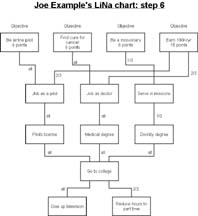
Click to enlarge
The Life Navigation (LiNa) chart is a tool for success. It helps you identify what you want to do with your life and how to get there.
Charting helps by identifying areas that are far more important than imagined. It also shows that some of our short-term goals are really side-trips. The path to success is short for those with a plan.
Finally, the chart will help you make a plan by laying everything out visually. You can see the path to success.
Joe Example is based on some real people. He will help explain how to make the chart. Joe still has a lot to learn about life, as we shall see. Nonetheless the chart will help set him on the right track.
Some people should not use the LiNa chart. The most valuable thing this tool does is help identify the things people put a high priority on that are a waste of their time. These things dont help much towards any goal that is important to them. Unfortunately most people decide to keep doing them anyway. dont waste your time with this chart if you arent willing to give up things you like to get to the place you want to go.
Also, this chart shows the things we need to do to reach our goals, but dont want to do at all. dont waste your time on this chart if you arent willing to do whatever you must to reach your goals. If you didnt have to do these things you would have reached your goals already.
Everyone has dreams, so write them down. Write down between 1 and 3 objectives for each category.
You need between 12 and 24 objectives. If you have less than 12 you aren't done yet. If you have more than 24 you need to thin the list.
You can have objectives that seem to contradict each other. This is OK because you need to do the same things to reach both of them and you can decide later. If you imagine yourself both as a celibate catholic priest and a CEO with 6 kids you would still need to be healthy and go to college to do either one.
Four of Joe Example's are "Earn $100,000/year" (financial), "Be a missionary" (service), "Find a cure for cancer" (he is unlikely to do it), and "airline pilot career". Note that his objectives seem be contradictory (missionary vs. pilot vs. doctor). This is OK.
Some objectives are more important than others and some are more achievable than others. Rank your objectives so you can concentrate.
You now have 12-24 important objectives. Don't use all of them on your first LiNa chart to keep things simpler and easier.
Earning $100K/yr is Joe Example's primary objective. Two of his core objectives are to be a missionary and find a cure for cancer. The airline pilot career is one of his vital objectives. He has more objectives, but we will look at these four.
Each objective has stepping-stones leading up to it. Write down the stepping-stones for every objective. Many objectives have the same stepping-stones. Some objectives are also stepping-stones.
For Joe Example to have an airline pilot career he must first get a job as a pilot, which requires a pilot's license, which requires college. But Joe doesn't have time for college. His career in the food service industry doesn't give him time and there are too many good things on ESPN. Going to college requires cutting back his hours and giving away his TV. There are a lot of stepping-stones to get to this objective.
For Joe to find a cure for cancer he needs to be a doctor. To be a doctor he needs a Ph.D., and that means college. This degree also requires less hours and no TV.
Joe believes that to be a missionary he must first serve in the missions field for a while, and he believes he needs a degree in divinity for that. The degree requires college. Again there are common stepping-stones.
Joe could make $100K/yr many ways, but he is making a job as a doctor or an airline pilot into stepping-stones for this salary. Two of his objectives are stepping-stones for a third.
Draw a chart like the example below. Just hook up the objectives and stepping-stones and don't worry about numbers yet. Those come later. To keep things small, only use vital objectives if this is your first LiNa chart.
You might need two or three tries before things aren't messy with lines looping all over the place. You already have an idea about which stepping-stones will get the most traffic, so lay them first.
Joe Example should put "Go to college" in the middle of the paper, about a third of the way from the bottom. You should do the same with your stepping-stones that keep showing up.
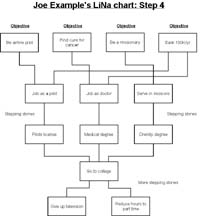
Assign a point value of 16 to your primary objective. Assign a point value of 8 to each core objective. Assign a point value of 4 to each vital objective. Assign a point value of 2 to each important objective.
A few of your stepping-stones may be minor objectives themselves. Assign them 1 point if you have any.
Joe Example wants a pilot's license badly, but not enough to make it an important objective. He assigns it 1 point since it is already on the chart.
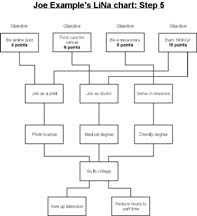
The lines connecting stepping-stones are "dependencies". Some objectives require certain stepping-stones. Sometimes the stepping-stone only helps you reach the objective.
Label each line as follows:
Joe Example decided that cutting back his hours is important for college. He didn't think it was absolutely necessary because he could take half as many classes for twice as long and still work full time.
Joe decided getting rid of the TV is required for college because he won't do much homework if a game is on.

Start with the objectives and work your way down. Each stepping-stone inherits points from everything that depends on it. If the stepping-stone is an objective add the value for that as well.
Some stepping-stones will be worth more than any of your objectives. This is because those stepping-stones lead you toward success so many ways.
'Required' stepping-stones inherit the full point value down the dependency. 'Important' stepping-stones inherit 2/3 of the points, and 'helpful' ones inherit 1/3. Round to the closest whole number.
Joe is weighting "Job as a doctor". Only a doctor can find a cure for cancer (8 point objective), so it inherits 8 points from that dependency. It is important for earning $100K/yr (16 points), so it inherits 10 more points (2/3 of 16 is 10). This stepping-stone is worth 18 points.
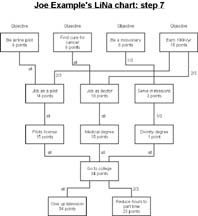
Follow the chains of high-value stepping-stones. These are your critical paths. Most charts only have one critical path.
If you have more than one critical path you should find the "high value path". This is the path through the chart that picks up the maximum number of points.
Joe Example only has one critical path, as shown below. It is "stop watching TV", "Go to college", "Medical degree", "Job as doctor", and "Earn $100K/yr".
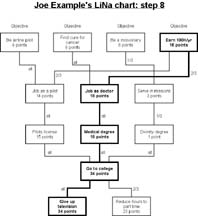
There are a few stepping-stones that are chokepoints on the roads to success. Identify them. You need to prepare for them ahead of time because you are less likely to succeed if you don't overcome them.
Joe Example has an obvious key stepping-stone: "Go to college". All paths to success on the chart he made use that stepping-stone. He can work around anything else, but not that. Joe noticed that "Stop watching TV" is required for college. If he can't get rid of the TV and go to college he could be bussing tables for a long time.
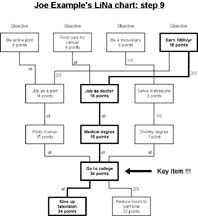
Make a plan that gets you the combination of objectives you want the most. Use the critical paths as much as possible.
Joe Example made the following plan:
Joe has made a decent plan with two weak points. First, not everyone who wants to become a doctor succeeds. Second, he probably won't find a cure for cancer, though he could make significant contributions.
Make a few other plans using different combinations of objectives you would like to have almost as much.
Show your chart and your plan to a few people who's opinion you respect and talk it over. Find the weak points in your plan. Make contingency plans that assume you didn't make it past one of these uncertainties.
Avoid talking to "wing-clippers", who will ridicule you or tell you that you can't do things that look hard to them. If they can't succeed, then you shouldn't be able to either.
Joe Example has talked this over and discovered the realities of medical school (hard and expensive) and his likelihood of curing cancer, playing pro sports, acting, or being a rock star.
Joe's plan B goes like this:
Start today!
Joe Example started with no idea what he wanted to do with his life, just some vague dreams he never expected to live out. He didn't know much and had some misconceptions about what he thought he did know. He wound up with a plan that stands a good chance of putting him there in eight to twelve years. Even if many things don't work out as planned his critical path will still put him in a great place to begin plan B, or C.
See Joe Example's LINA chart
Make a new LiNa chart every year and after every life change. Every year your plan will be better and your objectives more refined. Sometimes your plan or critical path will change to become more effective.
My neighbor Steve smoked for many years. Emphysema stole his lungs too slowly for him to notice until pneumonia nearly killed him. So Steve called the #1 emphysema doctor in the state and said, "They told me I have emphysema. What is it and what do I do about it?" The doctor said, "Emphysema is a smoker's disease. If you quit you live and if you smoke you die. Do you understand what I just told you, son?"
Three weeks later I saw Steve with a cigarette in his mouth. He didn't have the willpower to stop smoking, though he knew it would kill him.
Do you have the willpower to do what it takes to live your dreams? Will Joe Example take an ax to the TV? Will Joe be a doctor who changes the world in his spare time or an ESPN watching busboy? Will Steve quit smoking in time to save his life? Will you take some chances and make some sacrifices?
The LiNa chart isn't the only tool for navigating life's hazards. They all work. They all have huge lists of success stories. Joe Example was cooked down from a bunch of real people's real stories. Most people who are doing what they want got there by making plans and sacrifices. Most people who are not living their dreams did not make both plans and sacrifices. This is the only real difference.
Some project management software can make Pert charts. These will save you a little work by drawing the chart for you. Hook up the objectives and stepping-stones as per step 4. Make a final objective called "done" that depends on all objectives that were not also stepping-stones. You must make all your objectives into stepping-stones to use software. Put the weight (point value) of each stepping-stone into the "time" or "days" field. The software will automatically highlight the main critical path and print it out in a nice, neat chart.